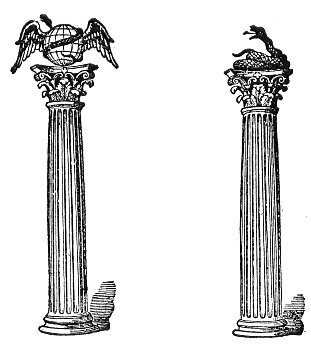The Jewish and early Christian writers looked on the worship of the sun and the elements with comparative indulgence. Justin Martyr and Clemens of Alexandria admit that God had appointed the stars as legitimate objects of heathen worship, in order to preserve throughout the world some tolerable notions of natural religion. It seemed a middle point between Heathenism and Christianity; and to it certain emblems and ordinances of that faith seemed to relate. The advent of Christ was announced by a Star from the East; and His nativity was celebrated on the shortest day of the Julian Calendar, the day when, in the physical commemorations of Persia and Egypt, Mithras or Osiris was newly found. It was then that the acclamations of the Host of Heaven, the unfailing attendants of the Sun, surrounded, as at the spring-dawn of creation, the cradle of His birth-place, and that, in the words of Ignatius, “a star, with light inexpressible, shone forth in the Heavens, to destroy the power of magic and the bonds of wickedness; for God Himself had appeared, in the form of man, for the renewal of eternal life.”
But however infinite the variety of objects which helped to develop the notion of Deity, and eventually assumed its place, substituting the worship of the creature for that of the creator; of parts of the body, for that of the soul, of the Universe, still the notion itself was essentially one of unity. The idea of one
p. 512
[paragraph continues] God, of a creative, productive, governing unity, resided in the earliest exertion of thought: and this monotheism of the primitive ages, makes every succeeding epoch, unless it be the present, appear only as a stage in the progress of degeneracy and aberration. Everywhere in the old faiths we find the idea of a supreme or presiding Deity. Amun or Osiris presides among the many gods of Egypt; Pan, with the music of his pipe, directs the chorus of the constellations, as Zeus leads the solemn procession of the celestial troops in the astronomical theology of the Pythagoreans. “Amidst an infinite diversity of opinions on all other subjects,” says Maximus Tyrius, “the whole world is unanimous in the belief of one only almighty King and Father of all.”
There is always a Sovereign Power, a Zeus or Deus, Mahadeva or Adideva, to whom belongs the maintenance of the order of the Universe. Among the thousand gods of India, the doctrine of Divine Unity is never lost sight of; and the ethereal Jove, worshipped by the Persian in an age long before Xenophanes or Anaxagoras, appears as supremely comprehensive and independent of planetary or elemental subdivisions, as the “Vast One” or “Great Soul” of the Vedas.
But the simplicity of belief of the patriarchs did not exclude the employment of symbolical representations. ‘Fl mind never rests satisfied with a mere feeling. That feeling ever strives to assume precision and durability as an idea, by some outward delineation of its thought. Even the ideas that are above and beyond the senses, as all ideas of God are, require the aid of the senses for their expression and communication. Hence come the representative forms and symbols which constitute the external investiture of every religion; attempts to express a religious sentiment that is essentially one, and that vainly struggles for adequate external utterance, striving to tell to one man, to paint to him, an idea existing in the mind of another, and essentially incapable of utterance or description, in a language all the words of which have a sensuous meaning. Thus, the idea being perhaps the same in all, its expressions and utterances are infinitely various, and branch into an infinite diversity of creeds and sects.
All religious expression is symbolism; since we can describe only what we see; and the true objects of religion are unseen. The earliest instruments of education were symbols; and they and all other religious forms differed and still differ according to
p. 513
external circumstances and imagery, and according to differences of knowledge and mental cultivation. To present a visible symbol to the eye of another is not to inform him of the meaning which that symbol has to you. Hence the philosopher soon super-added to these symbols, explanations addressed to the ear, susceptible of more precision, but less effective, obvious, and impressive than the painted or sculptured forms which he despised. Out of these explanations grew by degrees a variety of narratives, whose true object and meaning were gradually forgotten. And when these were abandoned, and philosophy resorted to definitions and formulas, its language was but a more refined symbolism, grappling with and attempting to picture ideas impossible to be expressed. For the most abstract expression for Deity which language can supply, is but a sign or symbol for an object unknown, and no more truthful and adequate than the terms Osiris and Vishnu, except as being less sensuous and explicit. To say that He is a Spirit, is but to say that He is not matter. What spirit is, we can only define as the Ancients did, by resorting, as if in despair, to some sublimized species of matter, as Light, Fire, or Ether.

Moe is the founder of GnosticWarrior.com. He is a father, husband, author, martial arts black belt, and an expert in Gnosticism, the occult, and esotericism.





